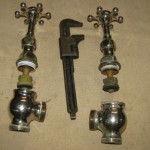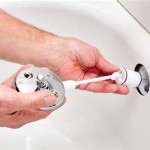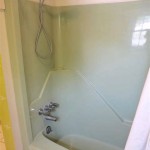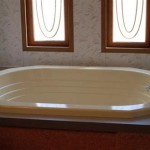How To Use a Snake to Unclog Your Bathtub
A clogged bathtub drain is a common household problem. Hair, soap scum, and other debris accumulate over time, restricting water flow and eventually leading to a complete blockage. While chemical drain cleaners offer a quick fix, they can damage pipes and pose a risk to the environment and personal health. A plumbing snake, also known as a drain snake or auger, provides a safer and more effective method for clearing bathtub clogs. This tool physically removes the blockage, rather than relying on chemicals to dissolve it.
Before beginning, it is essential to gather the necessary materials and take precautions to protect the bathtub's surface. This preparation minimizes the risk of damage and ensures a smooth and efficient unclogging process. Understanding the type of snake available and how to operate it properly are also crucial for success.
Preparing to Unclog Your Bathtub
Prior to beginning the unclogging process, it is important to assemble the necessary tools and prepare the area. The following steps outline the preparation process, ensuring efficiency and safety.
Gather Necessary Materials: The primary tool required is, of course, the plumbing snake. Snakes come in various lengths and diameters, so selecting one appropriate for bathtub drains is essential. Additionally, a pair of rubber gloves offers protection from grime and bacteria. A bucket or container will be useful for collecting any debris removed from the drain. A damp cloth or sponge will be needed for cleaning up any messes. A screwdriver may be necessary to remove the drain stopper. Finally, ensure adequate lighting to observe the drain and surrounding area clearly.
Protect the Bathtub Surface: The metal end of the plumbing snake can scratch or damage the bathtub's surface. Placing a towel or protective mat around the drain opening during the unclogging process can prevent such damage. This protective barrier will absorb any accidental contact between the snake and the tub's finish. Furthermore, preventing scratches and chips will prolong the lifespan and aesthetic appeal of the bathtub.
Remove the Drain Stopper: Before inserting the snake, the drain stopper must be removed. Most bathtub stoppers are either pop-up, lift-and-turn, or toe-touch designs. Pop-up stoppers typically have a small lever located near the overflow drain. Lifting this lever allows the stopper to be removed. Lift-and-turn stoppers require the stopper to be turned counterclockwise to loosen and then lifted out. Toe-touch stoppers usually require a slight twist and pull to remove. If the stopper does not come out easily, consult the bathtub's manual or search online for specific removal instructions for that type of stopper. If necessary, a screwdriver may be needed to loosen screws holding the stopper mechanism in place.
Using the Plumbing Snake
Once the preparation is complete, the actual unclogging process can begin. Careful insertion, manipulation, and removal of the snake are crucial for effectively clearing the clog without damaging the drain pipes.
Inserting the Snake: Carefully insert the end of the plumbing snake into the drain opening. Feed the snake slowly and steadily. If resistance is encountered, do not force it. Instead, gently rotate the snake while applying slight pressure. This twisting motion helps the snake navigate any bends in the drainpipe and work its way towards the clog. Avoid excessive force, as this can damage the snake or the pipes.
Locating and Breaking Up the Clog: As the snake continues down the drain,pay attention to any changes in resistance. When the snake encounters the clog, increased resistance will be felt. At this point, rotate the snake vigorously while pushing it further into the drain. The rotating action helps the snake to break up the clog into smaller pieces or to snag the clog so it can be pulled out. Continue this process until the resistance decreases, indicating that the clog has been broken up or moved. For particularly stubborn clogs, it may be necessary to repeat the process several times.
Removing the Snake and Debris: Once the clog appears to be broken up, slowly retract the plumbing snake from the drain. As the snake is being pulled out, use a gloved hand to remove any debris that is clinging to the snake. Place the removed debris in the bucket or container. Continue pulling the snake out until it is completely removed from the drain. Inspect the snake for any remaining debris and dispose of it properly. Running water down the drain afterwards helps to flush out any remaining small pieces of the clog.
Post-Unclogging Procedures and Maintenance
After successfully unclogging the bathtub drain, it is important to take steps to ensure proper drainage and prevent future clogs. This includes thorough cleaning and implementing regular maintenance practices.
Cleaning the Drain and Stopper: After removing the snake, thoroughly clean the drain opening and the drain stopper. Use a damp cloth or sponge to wipe away any remaining debris or grime from the drain. If the stopper is heavily soiled, it can be soaked in a mixture of warm water and mild detergent. Scrub the stopper with a brush or sponge to remove any stubborn buildup. Rinse the stopper thoroughly with clean water before reinserting it into the drain.
Testing the Drainage: After cleaning the drain and replacing the stopper, test the drainage by running water into the bathtub. Observe how quickly the water drains. If the water drains freely and without any gurgling sounds, the clog has been successfully removed. If the water drains slowly or the gurgling persists, there may still be a partial blockage. If this occurs, the unclogging process may need to be repeated, or a professional plumber may need to be consulted.
Preventing Future Clogs: Implementing preventative measures can significantly reduce the likelihood of future bathtub clogs. Installing a drain screen or strainer over the drain opening traps hair and other debris before they enter the drainpipe. Regularly cleaning the drain stopper and the surrounding area prevents buildup. Avoid pouring grease or oil down the drain, as these substances can solidify and contribute to clogs. Periodically flushing the drain with hot water can help to dissolve soap scum and other residue. Finally, consider using enzyme-based drain cleaners instead of harsh chemical cleaners, as they are less damaging to pipes and the environment.
Choosing the right snake is important. There are a variety of plumbing snakes available, each designed for specific purposes and drain sizes. For a bathtub drain, a smaller, more flexible snake is generally recommended. A cable snake, also known as a drum auger, is a common choice. This type of snake consists of a flexible metal cable coiled inside a drum. The cable is extended into the drain by turning a handle on the drum. Cable snakes are effective for navigating bends in the drainpipe and for breaking up or retrieving clogs. Another option is a flat tape snake, which is a flat, flexible metal tape with a hooked end. Flat tape snakes are less prone to kinking than cable snakes and are useful for clearing clogs near the drain opening. For shallow clogs, a simple hook-shaped tool, sometimes called a hair snake, can be used to manually remove hair and debris from the drain.
Proper maintenance of the plumbing snake itself is also necessary. After each use, thoroughly clean the snake with a damp cloth to remove any debris or grime. Apply a light coat of oil to the metal cable to prevent rust and corrosion. Store the snake in a dry place to further protect it from damage. Following these maintenance practices will prolong the lifespan of the plumbing snake and ensure its effectiveness for future unclogging tasks. Furthermore, understanding the limitations of a plumbing snake is important. While a snake can effectively clear many common bathtub clogs, it may not be able to handle more severe blockages, such as tree roots or collapsed pipes. In such cases, professional plumbing assistance is required.
Finally, while attempting to unclog a bathtub drain with a snake is a common DIY task, it is important to prioritize safety. Wear rubber gloves to protect hands from bacteria and grime. Avoid using excessive force when inserting or manipulating the snake, as this can damage the pipes or the snake itself. If there is any uncertainty about the type of clog or the proper technique, it is always best to consult with a qualified plumber. Taking these safety precautions will ensure a successful and worry-free unclogging experience. Regular maintenance is key to avoiding complex plumbing issues.
Bathtub Has Been Extremely Slow Draining Clogged For What Seems Like Years And All Methods We Ve Tried To Fix Draino Snakes Etc Are Inconsistent Any Permanent Solutions Quora
Bathtub Has Been Extremely Slow Draining Clogged For What Seems Like Years And All Methods We Ve Tried To Fix Draino Snakes Etc Are Inconsistent Any Permanent Solutions Quora

Value Optimized How To Unclog A Bathtub Drain Using Snake Clogged

How To Unclog Bathtub Drain Pipes And Save 200

Best Way To Unclog Bathtub Shower Drain Hair Snake

How To Unclog A Bathtub Drain

How To Unclog A Bathtub Drain 11 Diy Clog Busters

How To Unclog A Bathtub Drain Snake

How Do You Clean A Trip Lever Drain 3 Steps Done

How To Snake A Drain Sink Tub Toilet More
Related Posts








